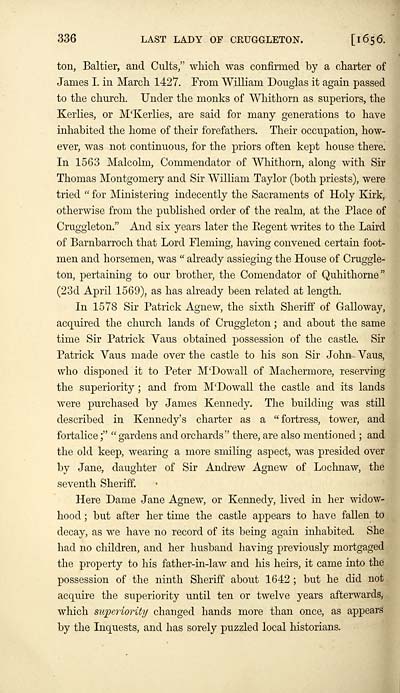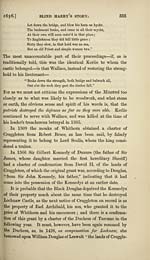Agnews of Lochnaw
(368) Page 336
Download files
Complete book:
Individual page:
Thumbnail gallery: Grid view | List view

336 LAST LADY OF CRUGGLETON. [1656.
ton, Baltier, and Cults," which was confirmed by a charter of
James I. in March 1427. From William Douglas it again passed
to the church. Under the monks of Whithorn as superiors, the
Keiiies, or M'Kerlies, are said for many generations to have
inhabited the home of their forefathers. Their occupation, how-
ever, was not continuous, for the priors often kept house there.
In 1563 Malcolm, Commendator of Whithorn, along with Sir
Thomas Montgomery and Sir William Taylor (both priests), were
tried " for Ministering indecently the Sacraments of Holy Kirk,
otherwise from the published order of the realm, at the Place of
Cruggleton." And six years later the Eegent writes to the Laird
of Barnbarroch that Lord Fleming, having convened certain foot-
men and horsemen, was " already assieging the House of Cruggle-
ton, pertaining to our brother, the Comendator of Quhithorne"
(23d April 1569), as has already been related at length.
In 1578 Sir Patrick Agnew, the sixth Sheriff of Galloway,
acquired the church lands of Cruggleton ; and about the same
time Sir Patrick Vaus obtained possession of the castle. Sir
Patrick Vaus made over the castle to his son Sir John Vaus,
who disponed it to Peter M'Dowall of Machermore, reserving
the superiority ; and from M'Dowall the castle and its lands
were purchased by James Kennedy. The building was still
described in Kennedy's charter as a "fortress, tower, and
fortalice ;" " gardens and orchards" there, are also mentioned ; and
the old keep, wearing a more smiling aspect, was presided over
by Jane, daughter of Sir Andrew Agnew of Lochnaw, the
seventh Sheriff.
Here Dame Jane Agnew, or Kennedy, lived in her widow-
hood ; but after her time the castle appears to have fallen to
decay, as we have no record of its being again inhabited. She
had no children, and her husband having previously mortgaged
the property to his father-in-law and his heirs, it came into the
possession of the ninth Sheriff about 1642 ; but he did not
acquire the superiority until ten or twelve years afterwards,
which superiority changed hands more than once, as appears
by the Inquests, and has sorely puzzled local historians.
ton, Baltier, and Cults," which was confirmed by a charter of
James I. in March 1427. From William Douglas it again passed
to the church. Under the monks of Whithorn as superiors, the
Keiiies, or M'Kerlies, are said for many generations to have
inhabited the home of their forefathers. Their occupation, how-
ever, was not continuous, for the priors often kept house there.
In 1563 Malcolm, Commendator of Whithorn, along with Sir
Thomas Montgomery and Sir William Taylor (both priests), were
tried " for Ministering indecently the Sacraments of Holy Kirk,
otherwise from the published order of the realm, at the Place of
Cruggleton." And six years later the Eegent writes to the Laird
of Barnbarroch that Lord Fleming, having convened certain foot-
men and horsemen, was " already assieging the House of Cruggle-
ton, pertaining to our brother, the Comendator of Quhithorne"
(23d April 1569), as has already been related at length.
In 1578 Sir Patrick Agnew, the sixth Sheriff of Galloway,
acquired the church lands of Cruggleton ; and about the same
time Sir Patrick Vaus obtained possession of the castle. Sir
Patrick Vaus made over the castle to his son Sir John Vaus,
who disponed it to Peter M'Dowall of Machermore, reserving
the superiority ; and from M'Dowall the castle and its lands
were purchased by James Kennedy. The building was still
described in Kennedy's charter as a "fortress, tower, and
fortalice ;" " gardens and orchards" there, are also mentioned ; and
the old keep, wearing a more smiling aspect, was presided over
by Jane, daughter of Sir Andrew Agnew of Lochnaw, the
seventh Sheriff.
Here Dame Jane Agnew, or Kennedy, lived in her widow-
hood ; but after her time the castle appears to have fallen to
decay, as we have no record of its being again inhabited. She
had no children, and her husband having previously mortgaged
the property to his father-in-law and his heirs, it came into the
possession of the ninth Sheriff about 1642 ; but he did not
acquire the superiority until ten or twelve years afterwards,
which superiority changed hands more than once, as appears
by the Inquests, and has sorely puzzled local historians.
Set display mode to:
![]() Universal Viewer |
Universal Viewer | ![]() Mirador |
Large image | Transcription
Mirador |
Large image | Transcription
Images and transcriptions on this page, including medium image downloads, may be used under the Creative Commons Attribution 4.0 International Licence unless otherwise stated. ![]()
| Histories of Scottish families > Agnews of Lochnaw > (368) Page 336 |
|---|
| Permanent URL | https://digital.nls.uk/94902530 |
|---|
| Description | A selection of almost 400 printed items relating to the history of Scottish families, mostly dating from the 19th and early 20th centuries. Includes memoirs, genealogies and clan histories, with a few produced by emigrant families. The earliest family history goes back to AD 916. |
|---|

